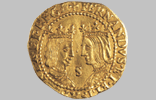Back Reign of the Catholic Monarchs

The reign of the Catholic Monarchs spanned the years between 1474 and 1504. It marked the beginning of a period of great progress and prosperity that would put Spain at the head of Europe for over a century.
By the determination of the Catholic Monarchs, Spain played the leading role in events of such significance that they would mark the course of its history, such as the unification of the different kingdoms under the Crown, the definitive incorporation of the Canaries to the Castilian Crown, the annexation of the Nazarí Kingdom of Granada, or the landfall of Christopher Columbus in the New World.
The monetary system during the reign of the Catholic Monarchs

The monetary system was based on gold, silver and billon. The monetary diversity in existence in the different Spanish kingdoms on the accession of the Catholic Monarchs was influenced by two different areas: the Muslim and the European. The kingdoms that constituted the Crown of Aragon each issued their own coinage. During their reign Isabella and Ferdinand sought to unify the coin types, especially in Castile.

The first monetary standard for Castile is dated June 26, 1475. As the unit for gold it established the castellano, which depicted facing busts of the monarchs. It also established the doble castellano, a coin that was appointed the name of excelente on account of the purity of the metal used. This coin portrayed the sovereigns, and on the reverse the eagle of Saint John harbouring the coat-of-arms. For silver, the standard set the real, and its divisors, the medio real and the cuarto de real. In billon, an alloy of silver and copper, the coin to be minted was the blanca, with a motif representing the initials of the king and queen.
The "Pragmática" of Medina del Campo, dictated in 1497, established the guidelines for the minting of the new gold coin: the excelente de la granada (with the kingdom of Granada added to the coat-of-arms on the reverse), based on the Venetian ducat, a coin accepted in Europe and in use in Valencia and Aragon since 1483. This coin had multiples of 2, 4, 10 and 20, and a divisor, the medio excelente. This statutory provision was intended to unify the monetary system, and it also regulated the working of the mints and minters. A new denomination in silver was also introduced, the octavo de real.
By a Royal Warrant of 1503, Isabella commanded the coining in the Seville Mint of "the gold arriving from Hispaniola Island and from the other islands and lands of the Oceanic sea"; this mint would also strike coinage in silver and copper.